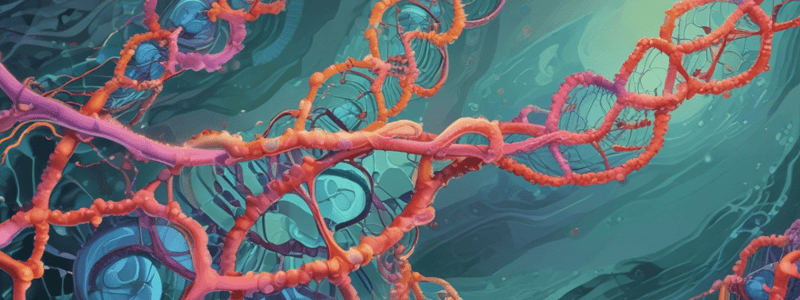Podcast
Questions and Answers
What is the primary role of the Mediator complex in gene regulation?
What is the primary role of the Mediator complex in gene regulation?
What is the outcome of transcription factor binding to cis-elements?
What is the outcome of transcription factor binding to cis-elements?
What is the primary function of chromatin remodeling complexes?
What is the primary function of chromatin remodeling complexes?
What is the role of coactivator complexes in gene regulation?
What is the role of coactivator complexes in gene regulation?
Signup and view all the answers
What is the primary mechanism of long-range gene regulation?
What is the primary mechanism of long-range gene regulation?
Signup and view all the answers
What is the significance of long-range gene regulation in development and cell differentiation?
What is the significance of long-range gene regulation in development and cell differentiation?
Signup and view all the answers
Study Notes
Enhancer-Promoter Interactions
- Enhancers are distal regulatory elements that can loop back to interact with promoters to activate transcription
- Looping mechanisms involve the formation of chromatin loops, bringing enhancers and promoters into close proximity
- Mediator complex plays a crucial role in facilitating enhancer-promoter interactions
- Enhancer-promoter interactions can occur over long distances, allowing for the regulation of gene expression from distant regions
Transcription Factor Binding
- Transcription factors (TFs) bind to specific DNA sequences to regulate gene expression
- TFs recognize and bind to cis-elements, such as enhancers, promoters, and silencers
- Binding of TFs to cis-elements can either activate or repress transcription, depending on the TF and its cofactors
- TFs can also interact with each other to form complexes that regulate gene expression
Chromatin Remodeling
- Chromatin remodeling complexes alter the structure of chromatin to facilitate access to transcription factors
- Remodeling complexes can either relax or compact chromatin, making it more or less accessible to TFs
- Chromatin remodeling is essential for transcriptional activation, as it allows TFs to bind to cis-elements
- Chromatin remodeling complexes can also be involved in the repression of gene expression
Coactivator/Corepressor Complexes
- Coactivator complexes are recruited by transcription factors to enhance transcription
- Coactivators can acetylate histones, relax chromatin, and recruit RNA polymerase to promote transcription
- Corepressor complexes are recruited by transcription factors to repress transcription
- Corepressors can deacetylate histones, compact chromatin, and inhibit RNA polymerase to repress transcription
Long-range Gene Regulation
- Long-range gene regulation involves the regulation of gene expression from distant regions, often through enhancer-promoter interactions
- Long-range regulation can occur through the formation of chromatin loops, bringing distant regions into close proximity
- Long-range regulation can also involve the interaction of multiple cis-elements, such as enhancers and silencers
- Long-range regulation is important for the coordinated regulation of gene expression during development and cell differentiation
Studying That Suits You
Use AI to generate personalized quizzes and flashcards to suit your learning preferences.
Description
This quiz covers the mechanisms of gene regulation, including enhancer-promoter interactions, transcription factor binding, chromatin remodeling, and long-range gene regulation. Understand how these processes work together to control gene expression.



